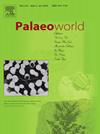The Early to Late Cretaceous (Albian–Cenomanian) transition in Putumayo, Colombia: A biostratigraphic and carbon isotope stratigraphic correlation for northwestern South America
IF 1.7
3区 地球科学
Q2 PALEONTOLOGY
引用次数: 0
Abstract
Despite the rich geological and paleontological record of Colombia, the Putumayo region near Ecuador remains one of the least explored regions in the equatorial Neotropics, mainly due to its thick vegetation, deep rock weathering, soil formation and ground cover, geographic remoteness, and inaccessibility of well-exposed outcrops. This has resulted in limited comparisons with neighboring basins and thus the generation of more comprehensive biostratigraphic correlations with western and northern South America, as well as other paleobiogeographic regions (e.g., Tethys, Western Interior Seaway). Here, we present 67 occurrences of uppermost Lower Cretaceous to lowermost Upper Cretaceous ammonoids and other macrofossils (e.g., bivalves, decapod crustaceans, osteichthyan fish remains, plant remains), as well as a δ13Corg chemostratigraphic curve derived from 105 samples from the middle Albian of the uppermost Caballos Formation and the upper Albian to lower Cenomanian lower Villeta Formation, collected in situ from a stratigraphic section exposed along the Mocoa–San Francisco Road, Putumayo, Colombia, here called the San Francisco section. The chemostratigraphic, carbon-isotope curve for the region shows a great similarity with the shape of the accepted curve for the late Albian Oceanic Anoxic Event 1d, which is characterized by a worldwide long positive δ13C excursion anomaly. The new biostratigraphic and isotopic data serve as a point of reference to compare the Putumayo Basin with neighboring basins (e.g., Marañon Basin in Perú, Oriente Basin in Ecuador, Upper Magdalena Valley Basin in Colombia), and thus the generation of more comprehensive upper Lower Cretaceous and lower Upper Cretaceous biostratigraphic and chemostratigraphic correlations for northwestern South America.
哥伦比亚普图马约早白垩世向晚白垩世(阿尔卑斯-塞诺曼)的过渡:南美洲西北部的生物地层和碳同位素地层相关性
尽管哥伦比亚拥有丰富的地质和古生物记录,但靠近厄瓜多尔的普图马约地区仍然是赤道新热带地区探索最少的地区之一,这主要是由于该地区植被茂密、岩石风化程度深、土壤形成和地面覆盖、地理位置偏远以及无法获得暴露良好的露头。这导致与邻近盆地的比较有限,因而无法与南美洲西部和北部以及其他古生物地理区域(如特提斯山脉、西内陆海道)建立更全面的生物地层关联。在此,我们介绍了 67 个地点出现的下白垩世最上至上白垩世最下层的氨类动物和其他大型化石(如双壳类动物、十足类甲壳)、这些样本采集自哥伦比亚普图马约省莫科阿-圣弗朗西斯科公路沿线出露的一个地层剖面,这里称为圣弗朗西斯科剖面。该地区的化学地层碳同位素曲线与公认的晚白垩世大洋缺氧事件 1d 的曲线形状非常相似,后者的特点是全球范围内出现了长δC 正偏移异常。新的生物地层学和同位素数据可作为普图马约盆地与邻近盆地(如秘鲁马拉尼翁盆地、厄瓜多尔奥连特盆地、哥伦比亚上马格达莱纳河谷盆地)进行比较的参照点,从而为南美洲西北部建立更全面的上白垩世和下白垩世生物地层学和化学地层学关联。
本文章由计算机程序翻译,如有差异,请以英文原文为准。
求助全文
约1分钟内获得全文
求助全文
来源期刊

Palaeoworld
PALEONTOLOGY-
CiteScore
4.00
自引率
5.90%
发文量
95
期刊介绍:
Palaeoworld is a peer-reviewed quarterly journal dedicated to the study of past life and its environment. We encourage submission of original manuscripts on all aspects of palaeontology and stratigraphy, comparisons of regional and global data in time and space, and results generated by interdisciplinary investigations in related fields. Some issues will be devoted entirely to a special theme whereas others will be composed of contributed articles. Palaeoworld is dedicated to serving a broad spectrum of geoscientists and palaeobiologists as well as serving as a resource for students in fields as diverse as palaeobiology, evolutionary biology, taxonomy and phylogeny, geobiology, historical geology, and palaeoenvironment.
Palaeoworld publishes original articles in the following areas:
•Phylogeny and taxonomic studies of all fossil groups
•Biostratigraphy, chemostratigraphy, chronostratigraphy
•Palaeoecology, palaeoenvironment and global changes throughout Earth history
•Tempo and mode of biological evolution
•Biological events in Earth history (e.g., extinctions, radiations)
•Ecosystem evolution
•Geobiology and molecular palaeobiology
•Palaeontological and stratigraphic methods
•Interdisciplinary studies focusing on fossils and strata
 求助内容:
求助内容: 应助结果提醒方式:
应助结果提醒方式:


